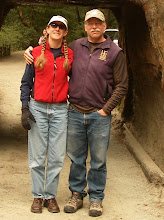
This must be one of the two hundred year old trees that Panagiotis (our olive farmer friend) told us about. There were also fields of maturing melons grown with buried drip tape on mulched beds, greenhouses full of huge tomato plants, and fields of potatoes, zucchini, and lettuce. Here was a crew harvesting some iceberg lettuce.

The soil is a dark red clay and in Messinia the fields are not full of rocks. Drip irrigation is extensively used and the farmers work up the ground to a fine tilth. The early fields were covered in row cover as shown in the background of the following picture. The shrine of the day appears to be made of slate.

Early in the ride, we were surprised by this monument in a small town's park. What connection could Filiatra, Greece have with Paris?

Our route today was flat to gently rolling. We made good time. The Greek drivers saw it as an opportunity to make good time as well, and some passed us going breathtakingly fast! It was also the first time we have seen traffic cops working the road, radar and everything, just like at home.
Tomorrow we hope to make it to Olympia, home of the Olympic torch!















































